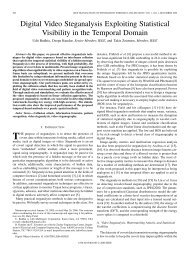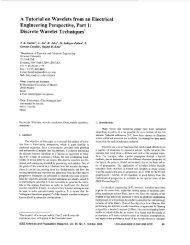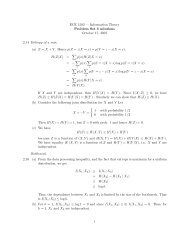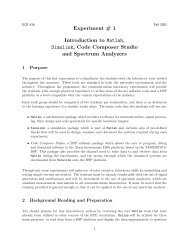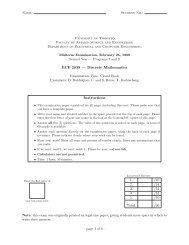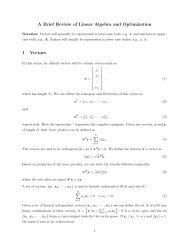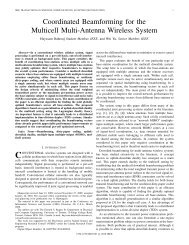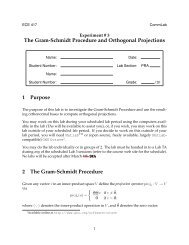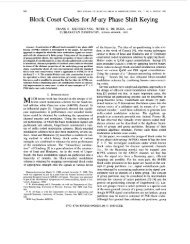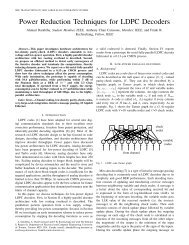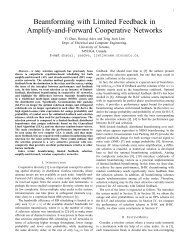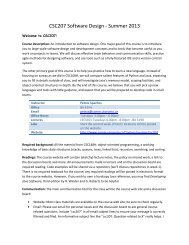On the use of cyber-physical hierarchy for - IEEE Xplore
On the use of cyber-physical hierarchy for - IEEE Xplore
On the use of cyber-physical hierarchy for - IEEE Xplore
You also want an ePaper? Increase the reach of your titles
YUMPU automatically turns print PDFs into web optimized ePapers that Google loves.
ON THE USE OF CYBER-PHYSICAL HIERARCHY FOR SMART GRID SECURITY AND<br />
EFFICIENT CONTROL<br />
Jin Wei, Deepa Kundur and Takis Zourntos<br />
Department <strong>of</strong> Electrical and Computer Engineering<br />
Texas A&M University, College Station, TX 77843, USA<br />
ABSTRACT<br />
We study <strong>the</strong> application <strong>of</strong> <strong>cyber</strong>-<strong>physical</strong> <strong>hierarchy</strong> on a class <strong>of</strong><br />
smart grid systems to improve scalability. Our framework employs a<br />
multi-agent flocking-based approach to study <strong>the</strong> transient stability<br />
problem in emerging power systems. An agent in this context embodies<br />
a coherent group <strong>of</strong> system generators. We demonstrate how<br />
our paradigm conveniently facilitates <strong>the</strong> identification <strong>of</strong> coherent<br />
machine clusters through spectral bisection <strong>of</strong> <strong>the</strong> associated Kronreduced<br />
power system graph. This enables a state-dependent system<br />
<strong>hierarchy</strong> whereby inter-agent interactions are <strong>cyber</strong>-<strong>physical</strong> (tier-<br />
1) and intra-agent synergies are <strong>physical</strong> (tier-2). By leveraging this<br />
layered perspective, active control can be employed only at a select<br />
“lead” generator <strong>of</strong> each agent; secondary generators that are necessarily<br />
coherent to a lead generator will naturally follow suit. Thus<br />
this <strong>cyber</strong>-<strong>physical</strong> <strong>hierarchy</strong> improves communications and energy<br />
overhead by introducing <strong>cyber</strong> couplings only within components<br />
<strong>of</strong> <strong>the</strong> smart grid where <strong>physical</strong> relationships are insufficient <strong>for</strong><br />
transient stability in <strong>the</strong> face <strong>of</strong> a incidental fault or intentional attack.<br />
We demonstrate <strong>the</strong> per<strong>for</strong>mance <strong>of</strong> our approach on <strong>the</strong> 9-bus<br />
WECC system demonstrating its lower overhead and greater robustness<br />
to <strong>cyber</strong> attacks resulting in in<strong>for</strong>mation delay.<br />
Index Terms— <strong>cyber</strong>-<strong>physical</strong> system security, smart grid <strong>hierarchy</strong>,<br />
flocking <strong>the</strong>ory.<br />
1. INTRODUCTION<br />
The smart grid design mantra <strong>for</strong> evolution can be described, in part,<br />
as “knowledge is power”. The application <strong>of</strong> in<strong>for</strong>mation technology<br />
to <strong>the</strong> power grid aims to provide more efficient and reliable operation<br />
and facilitate new consumer-centric applications through greater<br />
situational awareness. Advanced measurement devices and metering<br />
provide unprecedented opportunities <strong>for</strong> in<strong>for</strong>med decision-making.<br />
In<strong>for</strong>mation no doubt plays an important aspect <strong>of</strong> enhancing power<br />
system operation, but questions naturally arise as to when <strong>the</strong> increased<br />
measurement evokes needless data acquisition. Two practical<br />
considerations arise: 1) communications and computational overhead:<br />
redundant and irrelevant in<strong>for</strong>mation acquisition and <strong>use</strong> will<br />
result in excessive computational burden with limited per<strong>for</strong>mance<br />
return; 2) increasing risks <strong>of</strong> <strong>cyber</strong> attack: indiscriminate <strong>cyber</strong>dependence<br />
and -connectivity increases <strong>the</strong> scope and impact <strong>of</strong> potential<br />
<strong>cyber</strong> attacks. Thus, in this work, we focus, in part, on understanding<br />
how to best harness an appropriate degree <strong>of</strong> in<strong>for</strong>mation<br />
technology <strong>for</strong> power system operation.<br />
A preliminary version <strong>of</strong> this work has been submitted <strong>for</strong> panel presentation<br />
at <strong>the</strong> 2012 <strong>IEEE</strong> PES General Meeting. Funding was provided by<br />
<strong>the</strong> U.S. National Science Foundation under grant ECCS-1028246 and <strong>the</strong><br />
Norman Hackerman Advanced Research Program Project Number 000512-<br />
0111-2009.<br />
We take a <strong>for</strong>mal <strong>cyber</strong>-<strong>physical</strong> perspective and embody <strong>cyber</strong><br />
and <strong>physical</strong> interactions <strong>of</strong> <strong>the</strong> smart grid through graphical and<br />
dynamical systems representations. Cyber elements are introduced<br />
only when such interactions enhance <strong>the</strong> <strong>physical</strong> goals <strong>of</strong> <strong>the</strong> power<br />
system. Representing <strong>the</strong> overall <strong>cyber</strong>-<strong>physical</strong> system as a twotier<br />
<strong>hierarchy</strong> enables <strong>the</strong> effective identification <strong>of</strong> <strong>physical</strong> system<br />
insufficiencies and corresponding <strong>cyber</strong> system requirements.<br />
We focus on <strong>the</strong> problem <strong>of</strong> transient stability in <strong>the</strong> presence <strong>of</strong><br />
a system fault using distributed control based on wide area measurement<br />
data. We extend our prior work [1] by introducing <strong>hierarchy</strong> in<br />
<strong>the</strong> system through identification <strong>of</strong> coherent generator groups thus<br />
providing in<strong>for</strong>mation on <strong>physical</strong> couplings that can be leveraged to<br />
steer components <strong>of</strong> <strong>the</strong> smart grid to a state <strong>of</strong> stability. Each generator<br />
group is embodied by an agent such that inter-agent interactions<br />
are <strong>cyber</strong>-<strong>physical</strong> in nature. Intra-agent interactions occur amongst<br />
coherent generators and are correspondingly <strong>physical</strong> in nature. The<br />
requirements <strong>for</strong> <strong>cyber</strong> components and connectivity is reflected by<br />
<strong>the</strong> needs <strong>of</strong> active control at <strong>the</strong> agent-level which must drive <strong>the</strong><br />
overall system to stability.<br />
2. FLOCKING-BASED FRAMEWORK<br />
The derivation <strong>of</strong> our <strong>cyber</strong>-<strong>physical</strong> smart grid model is detailed<br />
in [1]. Here, we provide a brief overview <strong>of</strong> our framework. Our<br />
construction begins with a smart grid topology and aims to create<br />
a scalable depiction relating both <strong>physical</strong> and <strong>cyber</strong> components.<br />
To address issues <strong>of</strong> transient stability, <strong>the</strong>se ma<strong>the</strong>matical descriptions<br />
must relate generator rotor angles and frequencies. <strong>On</strong>e way<br />
to achieve this is to employ <strong>the</strong> classical swing equation model <strong>of</strong><br />
a synchronous generator on <strong>the</strong> Kron-reduced power system. The<br />
following well-known equations result <strong>for</strong> an N-generator system:<br />
N∑<br />
M i ˙ω i =−D iω i+P m,i−∣E i∣ 2 G ii− P ij sin(θ i − θ j + φ ij) (1)<br />
where i ∈{1, 2, ..., N} represents <strong>the</strong> generator index, θ i denotes<br />
<strong>the</strong> rotor phase angle measured with respect to a rotating frame reference<br />
at frequency f 0 =60Hz, ω i = ˙θ i is <strong>the</strong> relative normalized<br />
frequency, M i > 0 and D i > 0 represent <strong>the</strong> generator inertia<br />
and <strong>the</strong> damping parameters, respectively, E i, P m,i and G ii are<br />
<strong>the</strong> internal voltage, mechanical power input and equivalent shunt<br />
conductance <strong>of</strong> Generator i, respectively. P ij = ∣E i∣∣E j∣∣Y ij∣ and<br />
φ ij = arctan (G ij/B ij) where Y ij, G ij and B ij are <strong>the</strong> Kronreduced<br />
equivalent admittance, conductance and susceptance, respectively,<br />
between Generators i and j .<br />
We integrate <strong>the</strong> influence <strong>of</strong> <strong>the</strong> <strong>cyber</strong> network through an active<br />
control strategy in which power injection/absorption is employed at<br />
each generator bus to aid in transient stabilization in <strong>the</strong> face <strong>of</strong> <strong>physical</strong><br />
disruption. We assume that a fast-reacting power source P u,i<br />
j=1<br />
2012 25th <strong>IEEE</strong> Canadian Conference on Electrical and Computer Engineering (CCECE)<br />
978-1-4673-1433-6/12/$31.00 ©2012 <strong>IEEE</strong>
facilitated through smart grid technology such as flywheels or battery<br />
storage is available and its associated control signal u i = P u,i<br />
is computed by employing sensor measurements available through<br />
<strong>the</strong> <strong>cyber</strong> network. The <strong>cyber</strong>-<strong>physical</strong> coupling can <strong>the</strong>re<strong>for</strong>e be<br />
represented as:<br />
M i ˙ω i = −D iω i + P m,i + u<br />
}{{} i −∣E i∣ 2 G ii<br />
<strong>cyber</strong> influence<br />
N∑<br />
− P ij sin(θ i − θ j + φ ij). (2)<br />
j=1<br />
Eq. (2) carries <strong>the</strong> flavor <strong>of</strong> dynamical system models <strong>of</strong> flocking<br />
behavior [2]. Thus, inspired by <strong>the</strong> analogies present between <strong>the</strong><br />
requirements <strong>for</strong> transient stability and flocking rules in nature, we<br />
develop a flocking-based control protocol that consists <strong>of</strong> four terms:<br />
a gradient-based term to ensure phase angles <strong>of</strong> all synchronous generators<br />
are within 5π required <strong>for</strong> transient stability, a consensus<br />
9<br />
term to enable frequencies <strong>of</strong> all generators converge, navigation<br />
feedback so that frequencies converge to ω ∗ and a component designed<br />
to enable singular perturbation analysis. The resulting <strong>cyber</strong><strong>physical</strong><br />
system (<strong>physical</strong> power system with flocking-based <strong>cyber</strong><br />
control) can be described as [1]:<br />
{ ˙θ = ω<br />
M ˙ω = û = −∇V − Lω − Gω − c 1(ω − ω ∗ (3)<br />
)<br />
where θ =[θ 1,...,θ N ] T , ω =[ω 1,...,ω N ] T , M = D (I+B),<br />
I is <strong>the</strong> identity matrix, D = diag [D 1,...,D N ], B is a N × N<br />
<strong>cyber</strong> coupling matrix designed to relax <strong>the</strong> over-damped generator<br />
assumption, L is <strong>the</strong> <strong>physical</strong> coupling matrix which is determined<br />
by <strong>the</strong> impedances <strong>of</strong> <strong>the</strong> Kron-reduced power system topology, G is<br />
ano<strong>the</strong>r N ×N <strong>cyber</strong> coupling matrix designed to achieve frequency<br />
consensus, ∇V is <strong>the</strong> gradient-based term, c 1 is <strong>the</strong> parameter <strong>for</strong><br />
<strong>the</strong> linear navigational feedback and ω ∗ = 0 is <strong>the</strong> desired relative<br />
normalized generator frequency.<br />
The flocking-based active control strategy requires power injection/absorption<br />
at each generator bus to facilitate transient stability<br />
and increased critical clearing time. We next describe an approach<br />
to leverage <strong>the</strong> <strong>physical</strong> coupling amongst generators to apply such<br />
control only to “lead” generator b<strong>use</strong>s thus saving control cost while<br />
maintaining its functionality.<br />
3. TWO-TIER HIERARCHICAL CONTROL<br />
FRAMEWORK<br />
Scalability <strong>of</strong> our flocking-based approach <strong>for</strong> transient stability is<br />
facilitated through exploiting <strong>physical</strong> couplings amongst generators.<br />
We assert that by leveraging generator coherency, active control<br />
can be employed only at select lead generators <strong>for</strong> <strong>the</strong>ir stabilization;<br />
secondary generators that are necessarily coherent to one or more<br />
lead generators will naturally follow suit. To enable such an layered<br />
approach requires identifying generator coherency.<br />
3.1. Spectral Matrix-Based Generator Coherency Identification<br />
To identify generator coherency, we make <strong>use</strong> <strong>of</strong> insights recently<br />
presented by Dörfler and Bullo in [3] whereby it is shown via singular<br />
perturbation analysis that Eq. (1) is equivalent to:<br />
D iω i = P m,i −∣E i∣ 2 G ii −<br />
N∑<br />
P ij sin(θ i − θ j + φ ij). (4)<br />
j=1<br />
Taking <strong>the</strong> derivative <strong>of</strong> both sides, Eq. (4) can be compactly represented<br />
as [3]:<br />
D ˙ω = −Lω, (5)<br />
where D = diag [D 1,D 2,...,D N ], ω =[ω 1,...,ω N ] T , L is a<br />
N × N matrix whose elements l ij are defined as:<br />
{<br />
−Pij cos (θ i − θ j + φ ij) , if i ∕= j.<br />
l ij = ∑ N−1<br />
k=1 P (6)<br />
ik cos (θ i − θ k + φ ik ) , o<strong>the</strong>rwise.<br />
It can be shown that <strong>the</strong> matrix L can be interpreted as <strong>the</strong> Laplacian<br />
(with zero row-sum and positive semi-definite (PSD) character) <strong>of</strong> a<br />
directed weighted graph G associated with <strong>the</strong> power system topology<br />
<strong>for</strong> a small time interval after <strong>the</strong> fault is cleared; <strong>the</strong> associated<br />
weight <strong>of</strong> an edge e ij in G would be given by l ij.<br />
It is well known that <strong>for</strong> Laplacian matrices, <strong>the</strong> second smallest<br />
eigenvalue λ 2 represents <strong>the</strong> algebraic connectivity <strong>of</strong> its associated<br />
graph. Moreover, <strong>for</strong> our framework <strong>the</strong> signs <strong>of</strong> <strong>the</strong> elements <strong>of</strong><br />
<strong>the</strong> associated eigenvector v (called <strong>the</strong> Fedler vector) provide in<strong>for</strong>mation<br />
<strong>for</strong> spectral bisection [4, 5] to partition G into two relatively<br />
disjoint (in terms <strong>of</strong> <strong>physical</strong> coupling) subgraphs. In <strong>the</strong> case <strong>of</strong> bisection,<br />
one group <strong>of</strong> generators will represent high coherency and<br />
<strong>the</strong> o<strong>the</strong>r low.<br />
An algorithm to identify generator coherency is summarized in<br />
Table 1. We assume, as typical, that <strong>the</strong> number <strong>of</strong> generator groups<br />
to partition is known a priori and denoted θ; <strong>the</strong> algorithm is given<br />
<strong>for</strong> θ a power <strong>of</strong> two, but more general values <strong>of</strong> coherency groups<br />
can be considered if strategies <strong>for</strong> selective partitioning and joining<br />
<strong>of</strong> subgroups is applied at specific stages. The algorithm is faultdependent<br />
and real-time so that it can be applied shortly after a system<br />
fault is cleared to analyze coherency just prior to <strong>the</strong> application<br />
<strong>of</strong> control. After identification <strong>of</strong> coherent clusters, <strong>the</strong> two-tier<br />
hierarchical controlling framework described in <strong>the</strong> next section is<br />
applied.<br />
3.2. Two-Tier Hierarchical Control Framework<br />
In our two-tier hierarchical control framework, <strong>the</strong> power grid is<br />
modeled as a dynamical multi-agent system in which each agent consists<br />
<strong>of</strong> <strong>the</strong> generators with high <strong>physical</strong> coupling. The generator<br />
groupings within each agent are identified via <strong>the</strong> spectral matrixbased<br />
generator coherency identification algorithm <strong>of</strong> Table 1. In<br />
each agent, <strong>the</strong> generator having highest inertia is selected as <strong>the</strong><br />
lead component and <strong>the</strong> <strong>cyber</strong> control is applied only at <strong>the</strong> lead<br />
component. The active control guarantees transient stability <strong>of</strong> <strong>the</strong><br />
lead generators (tier-1) and <strong>the</strong> <strong>physical</strong> couplings facilitate overall<br />
consensus <strong>of</strong> <strong>the</strong> secondary generator frequency states (tier-2). As a<br />
result all generator frequencies converge to <strong>the</strong> reference frequency<br />
(i.e., typically 60 Hz) and phase cohesiveness is established.<br />
Under this tiered framework, <strong>the</strong> complexity <strong>of</strong> <strong>the</strong> overall <strong>cyber</strong><br />
control protocol is reduced and <strong>the</strong> <strong>cyber</strong> control law is established<br />
as presented in Eq. 3 and in [1] except that it is applied to <strong>the</strong> reference<br />
graph G <strong>of</strong> <strong>the</strong> two-tier system, created by taking <strong>the</strong> original<br />
graph <strong>of</strong> <strong>the</strong> Kron-reduced system and eliminating <strong>cyber</strong> links <strong>of</strong><br />
non-lead generators. Similarly, <strong>the</strong> Laplacian matrix ˜L <strong>use</strong>d <strong>for</strong> control<br />
computation is generated by excluding rows and columns from<br />
<strong>the</strong> original system Laplacian L <strong>of</strong> Eq. 5 that do not correspond to<br />
lead generators.<br />
Intuitively, it is clear that such a tiered approach provides scalability.<br />
However, questions naturally arise as to <strong>the</strong> per<strong>for</strong>mance<br />
<strong>of</strong> such an approach in stabilizing <strong>the</strong> system. What are <strong>the</strong> compromises<br />
with respect to computational complexity, communication
Table 1. Spectral Matrix Based Generator Coherency Identification<br />
Method<br />
Given a predetermined number <strong>of</strong> <strong>the</strong> generator groups:<br />
θ =2 C .<br />
1. Obtain <strong>the</strong> Laplacian matrix L by using Eq. (6).<br />
2. Calculate <strong>the</strong> eigenvector v corresponding to <strong>the</strong><br />
smallest nontrivial eigenvalue <strong>of</strong> <strong>the</strong> laplacian matrix.<br />
3. For k 1 =1:N<br />
if <strong>the</strong> kth element <strong>of</strong> <strong>the</strong> eigenvector v(k 1) > 0<br />
<strong>the</strong> kth generator belonging to <strong>the</strong> partition S +,<br />
else<br />
<strong>the</strong> k 1th generator belonging to <strong>the</strong> partition S −,<br />
end<br />
End<br />
4. If C>1<br />
<strong>for</strong> k 2 =2:C<br />
1). Remove <strong>the</strong> edges connecting <strong>the</strong> partitions<br />
S + and S − from <strong>the</strong> graph G and achieve two<br />
disconnected graphs G + and G − associated<br />
with S + and S −, respectively.<br />
2). For G + and G −, respectively, achieve <strong>the</strong><br />
associated Laplacian matrix L + and L − and<br />
repeat <strong>the</strong> steps 2 and 3.<br />
end<br />
Else End<br />
and energy overhead How sensitive is <strong>the</strong> system to in<strong>for</strong>mation<br />
delay stemming say from denial-<strong>of</strong>-service <strong>cyber</strong> attacks Do noncoherent<br />
groupings and <strong>the</strong> subsequent identification <strong>of</strong> incorrect<br />
lead generators reduce per<strong>for</strong>mance We evaluate <strong>the</strong> per<strong>for</strong>mance<br />
<strong>of</strong> our proposed two-tier hierarchical flocking-based <strong>cyber</strong>-<strong>physical</strong><br />
control framework with respect to <strong>the</strong>se metrics <strong>for</strong> <strong>the</strong> WECC 9-bus<br />
power system.<br />
4. PERFORMANCE CASE STUDY<br />
The WECC 9-bus power system power [6] is shown in Fig. 1. In<br />
order to demonstrate <strong>the</strong> utility <strong>of</strong> <strong>the</strong> proposed framework <strong>for</strong> wide<br />
area monitoring systems, <strong>the</strong> normalized impedance <strong>of</strong> each transmission<br />
line is increased from 0.1j (WECC standard) to 0.35j. The<br />
increase in impedance reduces <strong>the</strong> <strong>physical</strong> couplings amongst generators<br />
hence making <strong>the</strong> transient stability problem more challenging.<br />
After Kron-reduction, <strong>the</strong> dynamic graph associated with <strong>the</strong><br />
<strong>physical</strong> system is presented in Fig. 2(a). The graph consists <strong>of</strong> three<br />
nodes representing each <strong>of</strong> <strong>the</strong> three generators with associated dynamics<br />
described by Eq. (1). The edges represent <strong>physical</strong> coupling<br />
whereby <strong>the</strong> weight <strong>of</strong> <strong>the</strong> edge between G i and G j is given by Y ij,<br />
<strong>the</strong> Kron-reduced equivalent admittance between those generators.<br />
Our non-tiered approach to active control would require power<br />
injection P u,i at all three generator b<strong>use</strong>s and that all generators exchange<br />
in<strong>for</strong>mation to compute u i = P u,i asshowninFig.2(b).Our<br />
tiered approach naturally reduces communication overhead as control<br />
computation is required only amongst lead generators <strong>of</strong> each<br />
coherence group. For example, Figs. 2(c) and 2(d) represent two<br />
possible scenarios depending on <strong>the</strong> generators’ coherence.<br />
For this case study, we assume that a 3-phase short circuit fault<br />
occurs at Bus 6 <strong>of</strong> Fig. 1 at time t =0s and that <strong>the</strong> associated line<br />
is removed at t =0.3 s, after <strong>the</strong> critical clearing time. The system<br />
<br />
<br />
<br />
<br />
<br />
<br />
<br />
<br />
<br />
<br />
<br />
<br />
<br />
<br />
<br />
<br />
<br />
<br />
<br />
<br />
<br />
<br />
<br />
<br />
<br />
<br />
<br />
<br />
<br />
<br />
<br />
<br />
<br />
<br />
<br />
<br />
<br />
<br />
<br />
Fig. 1. WECC 9-bus power system [6]; in this work <strong>the</strong> normalized<br />
impedance <strong>of</strong> each transmission line is increased from 0.1j (WECC<br />
standard) to 0.35j.<br />
behavior is shown in Fig. 3 over a period <strong>of</strong> 10 s and as expected <strong>the</strong><br />
system does not achieve transient stability; <strong>the</strong> normalized frequencies<br />
and phase angles become unstable and phase angle differences<br />
diverge above 5π/9. The frequencies and phase angles <strong>of</strong> G 1 and<br />
G 2 overlap in plots Figs. 3(a) and (b) and have a zero phase angle<br />
difference as observed in Fig. 3(c) <strong>for</strong>ming a coherent group distinct<br />
<strong>for</strong>m G 3.<br />
When <strong>the</strong> proposed two-tier approach is applied, we assume that<br />
<strong>the</strong> generator coherency is identified at t =0.4 s, and <strong>the</strong> control is<br />
activated at t = 0.45 s. We identify <strong>the</strong> generator coherency by<br />
using our proposed spectral matrix-based generator coherency identification<br />
algorithm. The predetermined number <strong>of</strong> generator groups<br />
is θ =2thus spectral bisection is applied only once. At t =0.4 s,<br />
<strong>the</strong> Laplacian matrix L, eigenvalue λ 2 and associated Fedler vector<br />
v are given by:<br />
L =<br />
⎛<br />
⎝<br />
2.4465 −1.8037 −0.6428<br />
−1.8068 2.2250 −0.4182<br />
−0.6184 −0.3979 1.0164<br />
λ 2 = 1.5327,<br />
v = [−0.3663, −0.4715, 0.8022] T .<br />
⎞<br />
⎠ ,<br />
Based on <strong>the</strong> signs <strong>of</strong> <strong>the</strong> elements <strong>of</strong> <strong>the</strong> eigenvector v, we conclude<br />
that <strong>the</strong> θ =2agents consist <strong>of</strong>: {G 1,G 2} and {G 3}. The accuracy<br />
<strong>of</strong> <strong>the</strong> coherency identification results is validated by Fig. 3.<br />
After obtaining generator coherency identification results and<br />
selecting <strong>the</strong> lead component <strong>for</strong> each agent as <strong>the</strong> generator with<br />
greatest inertia, we achieve <strong>the</strong> two-tier hierarchical <strong>cyber</strong>-<strong>physical</strong><br />
control framework in Fig. 2(c). There are two agents, each consisting<br />
<strong>of</strong> a set <strong>of</strong> one or more generators with high <strong>physical</strong> coherency. The<br />
<strong>cyber</strong> links connect <strong>the</strong> lead generators G 1 and G 3 that must compute<br />
control signals as a function <strong>of</strong> one ano<strong>the</strong>r’s <strong>physical</strong> state. The<br />
distributed controllers determine u i = P u,i as detailed in <strong>the</strong> previous<br />
section. A maximum limit on <strong>the</strong> amount <strong>of</strong> power injected at<br />
each generator bus by <strong>the</strong> fast reacting grid is assumed; specifically,<br />
P u,i/P m,i ≤ 1 is assumed and <strong>for</strong> any u i = P u,i computed above<br />
this threshold, <strong>the</strong> power is assumed to be clipped. Fig. 4 presents <strong>the</strong><br />
normalized system frequency (<strong>the</strong> reader should note that <strong>the</strong> desired
1<br />
G 1<br />
Agent 1 Agent 2<br />
Agent 1 Agent 2<br />
G 2<br />
12 13<br />
G 1<br />
G 3<br />
G 1<br />
2 23<br />
3<br />
G 2 G 3<br />
G 2<br />
G 3<br />
(a)<br />
(b)<br />
(c)<br />
(d)<br />
Fig. 2. WECC 9-bus power system representations. Solid (dashed) lines represent <strong>physical</strong> (<strong>cyber</strong>) couplings. (a) Dynamical-graph representation<br />
<strong>of</strong> Kron-reduced system, (b) Cyber-<strong>physical</strong> couplings without <strong>hierarchy</strong>, (c) Hierarchical <strong>cyber</strong>-<strong>physical</strong> couplings <strong>for</strong> 3-phase short<br />
at Bus 6, (d) Possible two-tier <strong>hierarchy</strong>.<br />
Normalized Frequency<br />
1.8<br />
1.7<br />
1.6<br />
1.5<br />
1.4<br />
1.3<br />
1.2<br />
1.1<br />
G1<br />
G2<br />
G3<br />
1<br />
0 2 4 6 8 10<br />
Time (s)<br />
(a) Normalized frequencies versus time.<br />
Phase Angle (Degree)<br />
104 G1<br />
8<br />
G2<br />
G3<br />
6<br />
4<br />
2<br />
0<br />
−2<br />
0 2 4 6 8 10<br />
10 x Time (s)<br />
(b) Phase angles versus time.<br />
Phase Angle Difference (Degree)<br />
104 G1 and G2<br />
6 G1 and G3<br />
G2 and G3<br />
4<br />
2<br />
0<br />
−2<br />
−4<br />
−6<br />
−8<br />
0 2 4 6 8 10<br />
8 x Time (s)<br />
(c) Phase angle differences versus time.<br />
Fig. 3. Results <strong>for</strong> 3-phase short at Bus 6 when line is removed at t =0.3 s without application <strong>of</strong> flocking-based control; G 1 and G 2 <strong>for</strong>m<br />
a coherent group distinct from G 3.<br />
value is unity not zero as <strong>for</strong> <strong>the</strong> relative normalized frequency ω ∗ )<br />
and phase when <strong>the</strong> two-tier flocking-based <strong>cyber</strong>-<strong>physical</strong> control<br />
is activated at t =0.45 s. The injected power is shown in Fig. 6(a)<br />
and demonstrates clipping <strong>for</strong> G 1 and G 3; <strong>the</strong> injected power at bus<br />
G 2 is zero given <strong>the</strong> tiered architecture and its <strong>physical</strong> coherence to<br />
G 1.<br />
In contrast, Fig. 2(b) illustrates <strong>the</strong> flocking-based <strong>cyber</strong>-<strong>physical</strong><br />
control framework without <strong>the</strong> <strong>hierarchy</strong> [1]. All generators have<br />
<strong>the</strong> same priority and <strong>the</strong> <strong>cyber</strong> links exist connecting each generator<br />
pair; this full connectivity comes at <strong>the</strong> cost <strong>of</strong> communication<br />
overhead. Figure 6(b) shows <strong>the</strong> associated P u,i with clipping as<br />
discussed above. Thus, every generator pair is coupled through both<br />
<strong>cyber</strong> and <strong>physical</strong> means. This is in contrast to Fig. 2(c) in which<br />
all generators are coupled <strong>physical</strong>ly, but <strong>cyber</strong> coupling only exists<br />
between G 1 and G 3. Assuming that <strong>the</strong> control is activated at<br />
t = 0.4 s, Fig. 5 presents <strong>the</strong> results. Comparing Figs. 4 and 5<br />
we observe that our two-tier framework does not ca<strong>use</strong> noticeable<br />
reduction in maintenance <strong>of</strong> transient stability.<br />
Figure 6(c) compares <strong>the</strong> total power transmission between <strong>the</strong><br />
fast-reacting power grid and <strong>the</strong> WECC 9-bus power system by using<br />
<strong>the</strong> <strong>cyber</strong>-<strong>physical</strong> control framework with and without <strong>the</strong> two-tier<br />
hierarchical structure. The area under each power transmission curve<br />
determines <strong>the</strong> total energy exchanged between <strong>the</strong> fast acting grid<br />
and <strong>the</strong> WECC 9-bus system to enable transient stability in <strong>the</strong> face<br />
<strong>of</strong> <strong>the</strong> fault. Thus, <strong>the</strong> results validate <strong>the</strong> energy efficiency <strong>of</strong> our<br />
proposed two-tier hierarchical control framework.<br />
In order to evaluate <strong>the</strong> robustness <strong>of</strong> our approach to delays<br />
in <strong>cyber</strong> in<strong>for</strong>mation possibly stemming from denial-<strong>of</strong>-service <strong>cyber</strong><br />
attacks, we study <strong>the</strong> per<strong>for</strong>mance <strong>of</strong> our control strategy in <strong>the</strong><br />
face <strong>of</strong> in<strong>for</strong>mation delay. Figs. 7 and 8 evaluate <strong>the</strong> per<strong>for</strong>mances <strong>of</strong><br />
our hierarchical and non-hierarchical control strategies, respectively,<br />
under a communication delay <strong>of</strong> τ =0.05 s; here, <strong>the</strong> in<strong>for</strong>mation<br />
from neighboring generators <strong>use</strong>d <strong>for</strong> computation <strong>of</strong> u i is assumed<br />
to be delayed by τ. We observe that our hierarchical structure is<br />
more robust to communication delay as transient stability is facilitated<br />
whereas <strong>for</strong> <strong>the</strong> non-hierarchical case instability results. We<br />
believe that <strong>the</strong> reason <strong>for</strong> this stems from <strong>the</strong> greater dependence on<br />
<strong>physical</strong> couplings within <strong>the</strong> hierarchical approach which makes <strong>the</strong><br />
approach less susceptible to <strong>cyber</strong> attacks applied to <strong>the</strong> in<strong>for</strong>mation<br />
<strong>use</strong>d to compute <strong>the</strong> control laws.<br />
We emphasize that our two-tier approach requires that generator<br />
groupings within agents must exhibit <strong>physical</strong> coherence <strong>for</strong> correct<br />
identification <strong>of</strong> lead generators. For example, if <strong>for</strong> <strong>the</strong> case <strong>of</strong> <strong>the</strong><br />
3-phase short circuit at Bus 6 <strong>the</strong> generator groupings do not follow<br />
<strong>the</strong> results <strong>of</strong> <strong>the</strong> coherence identification method but instead <strong>the</strong> lead<br />
generators are selected to be G 1 and G 2 <strong>the</strong> hierarchical flockingbased<br />
control does not enable transient stability.<br />
5. FINAL REMARKS<br />
Overall, we have investigated <strong>the</strong> application <strong>of</strong> <strong>hierarchy</strong> <strong>for</strong> <strong>cyber</strong><strong>physical</strong><br />
control and security <strong>of</strong> smart grid systems. The generators<br />
within a smart grid are grouped into coherent clusters such that<br />
each cluster is embodied by an agent. The first layer in <strong>the</strong> two-tier<br />
framework reflects <strong>cyber</strong>-<strong>physical</strong> interactions amongst lead genera-
Normalized Frequency<br />
1.06<br />
1.04<br />
1.02<br />
1<br />
0.98<br />
0.96<br />
G1<br />
G2<br />
G3<br />
Phase Angle (Degree)<br />
500<br />
400<br />
300<br />
200<br />
100<br />
0<br />
G1<br />
G2<br />
G3<br />
Phase Angle Difference (Degree)<br />
150<br />
100<br />
50<br />
0<br />
−50<br />
−100<br />
G1 and G2<br />
G1 and G3<br />
G2 and G3<br />
0.94<br />
0 2 4 6 8 10<br />
Time (s)<br />
(a) Normalized frequencies.<br />
−100<br />
0 2 4 6 8 10<br />
Time (s)<br />
(b) Phase angles.<br />
−150<br />
0 2 4 6 8 10<br />
Time (s)<br />
(c) Phase angle differences.<br />
Fig. 4. Results <strong>for</strong> 3-phase short at Bus 6 when line is removed at t =0.3 s with proposed two-tier hierarchical <strong>cyber</strong>-<strong>physical</strong> control at<br />
t =0.45 s; no in<strong>for</strong>mation delay.<br />
Normalized Frequency<br />
1.04<br />
1.02<br />
1<br />
0.98<br />
0.96<br />
G1<br />
G2<br />
G3<br />
Phase Angle (Degree)<br />
500<br />
400<br />
300<br />
200<br />
100<br />
0<br />
G1<br />
G2<br />
G3<br />
Phase Angle Difference (Degree)<br />
150<br />
100<br />
50<br />
0<br />
−50<br />
−100<br />
−150<br />
G1 and G2<br />
G1 and G3<br />
G2 and G3<br />
0.94<br />
0 2 4 6 8 10<br />
Time (s)<br />
(a) Normalized frequencies.<br />
−100<br />
0 2 4 6 8 10<br />
Time (s)<br />
(b) Phase angles.<br />
−200<br />
0 2 4 6 8 10<br />
Time (s)<br />
(c) Phase angle differences.<br />
Fig. 5. Results <strong>for</strong> 3-phase short at Bus 6 when line is removed at t =0.3 s with non-hierarchical <strong>cyber</strong>-<strong>physical</strong> flocking control at t =0.4 s;<br />
no in<strong>for</strong>mation delay.<br />
Pu<br />
3<br />
2<br />
1<br />
0<br />
−1<br />
−2<br />
G1<br />
G2<br />
G3<br />
Pu<br />
3<br />
2<br />
1<br />
0<br />
−1<br />
−2<br />
G1<br />
G2<br />
G3<br />
Total Power Transmission<br />
6<br />
5<br />
4<br />
3<br />
2<br />
1<br />
With Hierarchical Structure<br />
Without Hierarchical Structure<br />
−3<br />
0 2 4 6 8 10<br />
Time (s)<br />
(a) Power transmission P u with <strong>hierarchy</strong>.<br />
−3<br />
0 2 4 6 8 10<br />
Time (s)<br />
(b) Power transmission P u without <strong>hierarchy</strong>.<br />
0<br />
0 2 4 6 8 10<br />
Time (s)<br />
(c) Total power transmission P u.<br />
Fig. 6. Power transmission between <strong>the</strong> fast-reacting power grid and <strong>the</strong> WECC 9-bus power system <strong>for</strong> 3-phase short at Bus 6.
Normalized Frequency<br />
1.06<br />
1.04<br />
1.02<br />
1<br />
0.98<br />
0.96<br />
G1<br />
0.94<br />
G2<br />
G3<br />
0.92<br />
0 2 4 6 8 10<br />
Time (s)<br />
(a) Normalized frequencies versus time.<br />
Phase Angle (Degree)<br />
500<br />
400<br />
300<br />
200<br />
100<br />
0<br />
G1<br />
G2<br />
G3<br />
−100<br />
0 2 4 6 8 10<br />
Time (s)<br />
(b) Phase angles versus time.<br />
Phase Angle Difference (Degree)<br />
200<br />
150<br />
100<br />
50<br />
0<br />
−50<br />
−100<br />
G1 and G2<br />
G1 and G3<br />
G2 and G3<br />
−150<br />
0 2 4 6 8 10<br />
Time (s)<br />
(c) Phase angle differences versus time.<br />
Fig. 7. Results <strong>for</strong> 3-phase short at Bus 6 when line is removed at t =0.3 s with proposed two-tier hierarchical <strong>cyber</strong>-<strong>physical</strong> control at<br />
t =0.45 s; τ =0.05 s.<br />
Normalized Frequency<br />
1.6<br />
1.5<br />
1.4<br />
1.3<br />
1.2<br />
1.1<br />
1<br />
G1<br />
G2<br />
G3<br />
Phase Angle (Degree)<br />
2.5 x 104 Time (s)<br />
2<br />
1.5<br />
1<br />
0.5<br />
0<br />
G1<br />
G2<br />
G3<br />
Phase Angle Difference (Degree)<br />
1<br />
0.5<br />
0<br />
−0.5<br />
−1<br />
1.5 x 104 Time (s)<br />
G1 and G2<br />
G1 and G3<br />
G2 and G3<br />
0.9<br />
0 2 4 6 8 10<br />
Time (s)<br />
(a) Normalized frequencies versus time.<br />
−0.5<br />
0 2 4 6 8 10<br />
(b) Phase angles versus time.<br />
−1.5<br />
0 2 4 6 8 10<br />
(c) Phase angle differences versus time.<br />
Fig. 8. Results <strong>for</strong> 3-phase short at Bus 6 when line is removed at t =0.3 s with non-hierarchical <strong>cyber</strong>-<strong>physical</strong> flocking control at t =0.4 s;<br />
τ =0.05 s.<br />
tors <strong>of</strong> agents and <strong>the</strong> second layer characterizes <strong>physical</strong> couplings<br />
amongst generators within an agent. Through <strong>the</strong> study <strong>of</strong> a <strong>cyber</strong><strong>physical</strong><br />
flocking-based control protocol on <strong>the</strong> WECC 9-bus system,<br />
we have demonstrated <strong>the</strong> potential <strong>of</strong> <strong>the</strong> approach in reducing<br />
communication and energy overhead required <strong>for</strong> control. This<br />
comes at <strong>the</strong> cost <strong>of</strong> increased computational complexity required<br />
<strong>for</strong> determining generator coherency <strong>for</strong> <strong>the</strong> <strong>for</strong>mation <strong>of</strong> generatorcluster<br />
agents in real-time. However, <strong>the</strong> hierarchical approach reduces<br />
control signal computation and decreases <strong>the</strong> <strong>cyber</strong> coupling<br />
amongst generators relying, in part, on <strong>physical</strong> coherence to achieve<br />
transient stability in <strong>the</strong> face <strong>of</strong> fault or <strong>cyber</strong>-<strong>physical</strong> attacks. We<br />
observe that this reduced <strong>use</strong> <strong>of</strong> in<strong>for</strong>mation makes <strong>the</strong> effective<br />
<strong>cyber</strong>-<strong>physical</strong> system inherently more robust against <strong>cyber</strong> attacks<br />
and in<strong>for</strong>mation delay.<br />
6. REFERENCES<br />
[1] J. Wei, D. Kundur, T. Zourntos, and K. Butler-Purry, “A<br />
flocking-based dynamical systems paradigm <strong>for</strong> smart power<br />
system analysis,” in Proc. <strong>IEEE</strong> Power Engineering Society<br />
General Meeting, San Diego, CA, July 2012.<br />
[2] R. Olfati-Saber, J. Fax, and R. Murray, “Consensus and cooperation<br />
in networked multi-agent systems,” Proceedings <strong>of</strong> <strong>the</strong><br />
<strong>IEEE</strong>, vol. 95, no. 1, pp. 215–233, January 2007.<br />
[3] F. Dörfler and F. Bullo, “Topological equivalence <strong>of</strong> a structurepreserving<br />
power network model and a non-uni<strong>for</strong>m Kuramoto<br />
model <strong>of</strong> coupled oscillators,” in Proc. <strong>IEEE</strong> Conference on Decision<br />
and Control and European Control Conference, Orlando,<br />
FL, December 2011, pp. 7099–7104.<br />
[4] M. Fiedler, “Algebraic connectivity <strong>of</strong> graphs,” Czechoslovak<br />
Ma<strong>the</strong>matical Journal, vol. 23, pp. 298–305, 1973.<br />
[5] A. Seary and W. Richards, Dynamic Social Network Modeling<br />
and Analysis. National Academies’ Press, 2003.<br />
[6] P. Sauer and M. Pai, Power System Dynamics and Stability.<br />
Prentice Hall, 1997.



